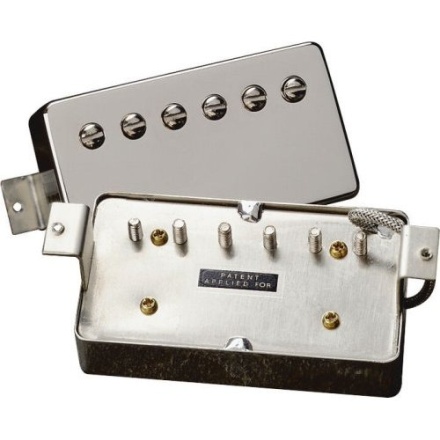Hard Mounted Guitar Pickups
There are quite a few manufacturers who have jumped on the hard mounted pickup bandwagon. Most of these manufacturers and independent builders will tout the extended sustain, meaty punch and greater overtones that come with hard mounted pickups, or direct coupling by another name. The problem is that most of them aren't performing a true hard mount. Many of these guys are simply screwing the ears of the pickup to the wood of the guitar top, and this is not same as a true hard mount. Putting wood screws through the ears of a pickup do not achieve the same results that true hard mounting achieves. On some pickups without polepiece screws, like single coils, the ear-mount is the only hard-mount option, but for most humbuckers you can acheive a true hard-mount.
A truly hard-mounted humbucker pickup utilizes all six (or more for 7 or 8 string guitars) of the polepiece screws adjacent to the polepiece slugs, that extend through the pickup itself. The image below shows how the screws extend through the pickup and out the other side. It is these six screws, screwed into the wood of the guitar that achieves a truly hard mounted pickup configuration.
This is a time consuming process that require precision measurements in the bridge height, pickup height and neck angle, as the pickups will never be adjustable for height, but when it done properly, the tone achieved by this configuration is amazing. An additional step that must be taken for chrome-covered pickups is to grind down the edges of the chrome covers so that they are flush with the bottom of the pickup, so that the screws can reach into the wood of the guitar.

Does Hard Mounting Really Make a Difference?
I would like to think that hard mounting makes a difference, as this technique is very time consuming and rather difficult to pull off properly. Every prototype built by me at Bertram Guitars utilizes hard mounting as described above. The pickups are screwed into the wood of the body NOT by the mounting brackets or "ears," but by the six polepiece screws adjacent to the polepiece slugs of the double coil Seymour Duncan pickups. I believe that this type of hard mounting results in increased sustain and a thicker meatier tone. I will qualify this statement to include that the only way one could know for absolutely certain would be to perform A B testing. This would entail a great deal of time consuming and expensive work.
For example, one would necessarily have to build a guitar with hard mounted pickups as described above and then perform a wide variety of tests and record these tests on a Pro Tools style professional system. Then, after the tests were successfully recorded, one would have to install pickup rings and then remount the same pickups so that they are floating inside the pickup route.
This would very likely involve removing additional wood to give the pickup room for adjustment or to in effect float from the springs. The act of removing additional wood may in and of itself effect the tone.
Then the same AB tests would have to be performed and recorded with the exact same recording system under the exact same circumstances.
Then and only then might one be able to truly know for certain, as one would be able to listen to the two recordings and decide if there is really a difference between hard mounted pickups and floating pickups.
